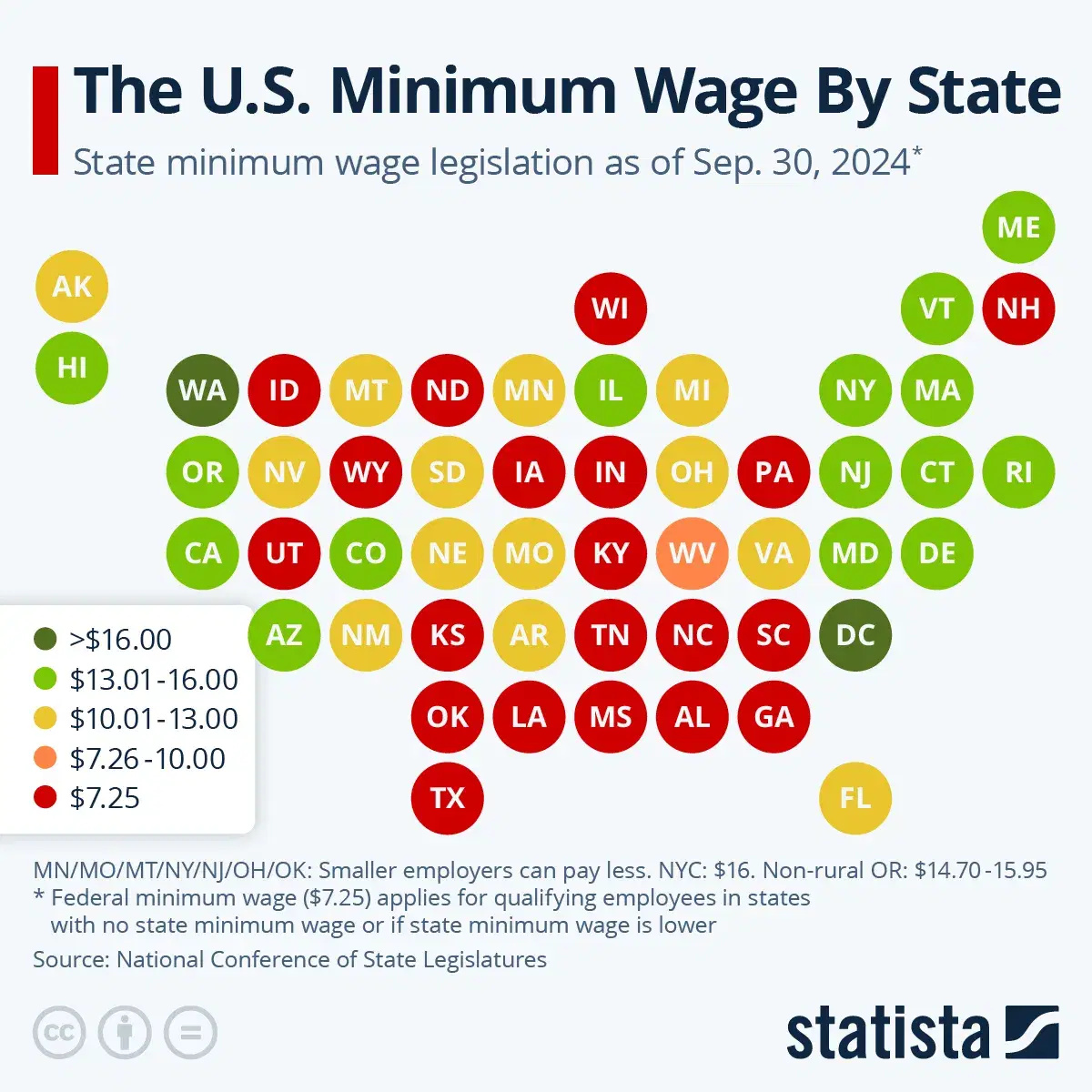![]()
See this visualization first on the Voronoi app.

Mapping the Minimum Wage of Each U.S. State
This was originally posted on our Voronoi app. Download the app for free on iOS or Android and discover incredible data-driven charts from a variety of trusted sources.
- 30 states and Washington D.C. have set minimum wages above the federal rate of $7.25/hour.
- California, Washington, and Hawaii lead the nation with wages above $16/hour.
- 20 states still rely on the federal minimum wage, which has not increased since 2009.
The U.S. has a patchwork of minimum wage laws across its 50 states, as shown in a new visualization from Statista using data from the National Conference of State Legislatures. As of September 2025, wages range from just $7.25 in many southern states to more than $16 in places like California, Washington, and Hawaii.
Here’s a breakdown of the state-level minimum wage rates in 2025:
| Minimum Wage Range | States |
|---|---|
| >$16.00 | CA, WA, HI |
| $13.01 - $16.00 | OR, AZ, CO, NM, NY, NJ, CT, MA, RI, VT, ME, DC, MD, DE |
| $10.01 - $13.00 | AK, MT, SD, NE, KS, MO, AR, MI, OH, WV, FL, IL |
| $7.26 - $10.00 | ID, NV, UT, WY, ND, MN, IA, KY, VA |
| $7.25 | OK, TX, LA, MS, AL, GA, TN, SC, NC, WI, IN, PA, NH |
At a glance, the map highlights the sharp divide: while states along the West Coast and Northeast offer significantly higher minimum wages, much of the South remains at the federal baseline of $7.25 per hour.
A Divided Wage Landscape
Today, 30 states and Washington D.C. mandate wages above the federal minimum. California’s $16.50 rate is among the highest nationwide, while Washington D.C. surpasses all with $17.50. Meanwhile, states like New Jersey, Connecticut, and New York City also set higher-than-average floors, reflecting stronger urban labor protections.
In contrast, 20 states including Texas, Florida, and North Carolina still pay at or near the federal minimum, which has remained unchanged since 2009.
States Without a Minimum Wage
Five states—Alabama, Louisiana, Mississippi, South Carolina, and Tennessee—have not enacted their own minimum wage laws. Alongside Georgia and Wyoming, which set minimum wages below $7.25, the federal standard applies instead. That means in these seven states, workers’ pay is tied directly to federal law.
Combined with 13 states pegged exactly to $7.25, a full 20 states currently sit at the national minimum.
The Growing Gap
As some states push ahead with higher wages to counter inflation and support low-income workers, others have stayed still, widening the gap across the country. For example, West Virginia’s $8.75 wage is still much closer to the federal minimum than to California’s $16.50.
Meanwhile, political debates continue to shape the future. In 2024, California voters narrowly rejected a ballot measure to raise the state’s wage to $18, signaling that even in high-cost states, the issue remains contentious.
Learn More on the Voronoi App
For a global comparison, explore our chart of Europe’s national minimum wages in 2025.